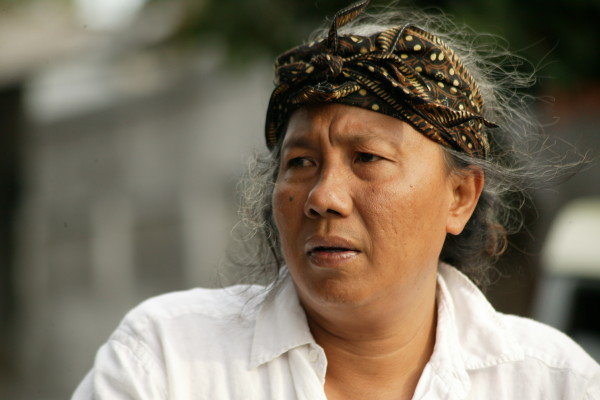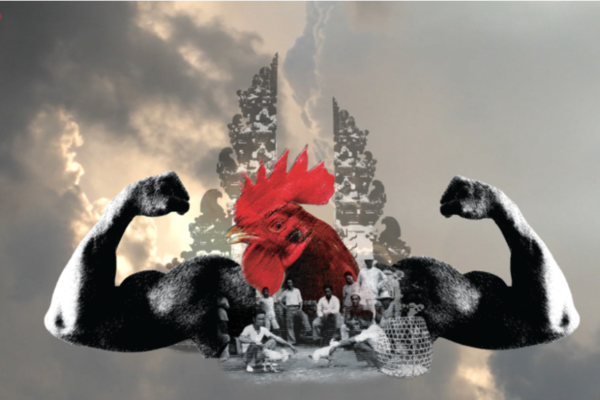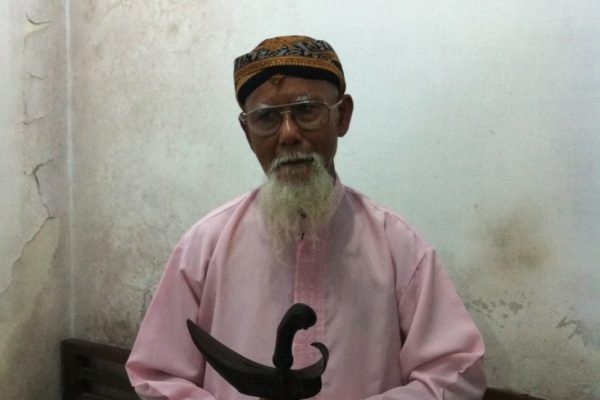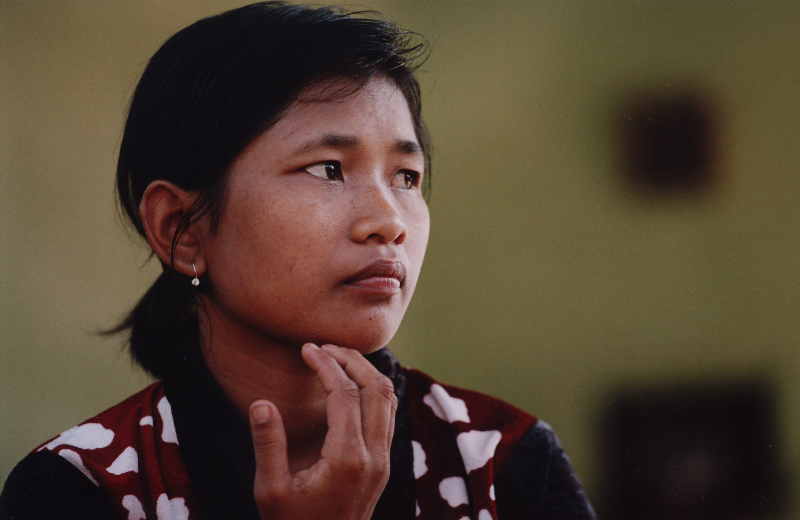When Robert Lemelson, an anthropologist, filmmaker, and research professor at UCLA, recently visited the George Washington University to speak at a conference on how ethnographic films can help us understand torture, I had to request an interview. I confess—I have long been a fan of Lemelson’s films, which I have seen screened at meetings as large as those of the American Anthropological Association and the Society for Psychological Anthropology, and as small as the Clinical Ethnography workshop at the University of Chicago.
Lemelson’s films have played at film festivals around the world. So, here are some tips for you.
Tip #1: Lemelson loves to screen his films to a wide variety of audiences, and if you invite him to screen his films for you, he may just agree to come and speak with your group.
Several of Lemelson’s films that I have seen are now part of a six-film series titled Afflictions: Culture and Mental Illness in Indonesia, which Lemelson produced and directed with Elemental Productions. This powerful series was nominated for Best Limited Documentary Series from the International Documentary Association Awards in 2010. The films have won numerous other awards, which can be viewed here.
Tip # 2: Rather than purchasing the film series yourself, it is ideal to request that it be purchased through your home institution’s library, which will make it available to your students (who will benefit from having access to the series), and faculty (who will enjoy using it as a teaching tool for various topics related to culture and global mental health). Or you can rent it on Amazon, etc.
The series consists of six, 20- to 45- minute ethnographic films on people diagnosed with severe mental illness in Indonesia. The series is based on material drawn from 12 years of person-centered research by Lemelson. In the spirit of psychological anthropology, the series follows six individuals of different ages and backgrounds across time to explore the relationship between culture, mental illness, and first-person experience. The films include (these titles hyperlink to trailers for each film): Memory of My Face, The Bird Dancer, Family Victim, Ritual Burdens, Shadows and Illuminations and Kites & Monsters.
As Lemelson and I settled in for his interview in the basement of the Red Cross building in Washington, DC, he told me that his commitments to the methods and theory of psychological anthropology, as well as his love for—and desire to experiment with—ethnographic film were the inspiration for this series. In general, Lemelson told me, he is committed to looking at anthropological concepts and their application to real-world problems. We must raise awareness of issues related to political economy, power, and gender, he claimed, because they are so important to solving global challenges.
Robert: I am trying to pioneer a kind of filmmaking that places people and their narratives at the forefront, or at least in an equal position with what is at stake theoretically for anthropology. As a psychological anthropologist, the subjects’ stories come first and telling those stories, informed by theory, is what the films are about. So stories are person-centered but they point to larger things.

Robert Lemelson and Nyoman Kereta and Family- the family highlighted in the film “Shadows and Illuminations”
What inspired the Afflictions Series?
These films tell the stories of the diagnosis, care and treatment of Indonesians suffering from mental “afflictions,” while analyzing the impact of cultural elements, such as kinship networks, symbol and ritual, stigma, gender, employment, politics, caregiving, and pharmaceutical and traditional treatments on the course of their illness.
The films were inspired by data presented in the DOSMED (Determinants of Outcome of Severe Mental Disorders) and IPSS (International Pilot Study of Schizophrenia) studies conducted by the World Health Organization. The IPSS was conducted in 1979 and investigated over 1200 young people with recent-onset functional psychosis in nine countries across the globe (China, Colombia, Czechoslovakia, Denmark, Nigeria, India, the USSR, the UK and the USA). The main finding of the IPSS was that people in the “developing countries” seemed to have better outcomes than people in the “developed countries.” Because the IPSS recruited people from psychiatric facilities, which may have been a confounding variable since help-seeking patterns can differ widely depending on social context, a second study (DOSMeD, 1992) was designed to correct this by recruiting people who were making their first contact with any helping agency and who had also received a diagnosis of schizophrenia.
This study recruited almost 1400 patients from 12 centers. At 2-year follow-up, the DOSMeD study confirmed the IPSS findings of a more favorable outcome in developing countries. Part of Lemelson’s dissertation research in the mid 1990’s was exploring the question of why people diagnosed with forms of severe mental illness in the developing world, in this case in Indonesia, had significantly better psychosocial outcomes than in the West. The Afflictions films have their origins in a number of his subjects from this research endeavor.
How did the findings of the DOSMeD and IPSS studies influence your own inquiry?
Robert: Well, these films – they all address issues related to better outcomes in the developing world for people with serious mental disorders. You can see it in the aggregate—all the films together. For example, what’s helpful for better outcome overall is social support. What’s disruptive is social isolation. People need valued roles—valued social roles. Labeling and attributions of illness also play important roles. For example, people can be psychotic but not viewed locally as mad. There is space for that in the Indonesian culture. You can see in the films how important non-stigmatizing labels may be and the important role of explanatory models. Take Gusti, for instance [a young woman from The Bird Dancer who experiences Tourette’s Syndrome]. Her family used local explanatory models that tend to stigmatize people like Gusti.
She is not really that ill, but because her family thinks she is bewitched and ancestrally cursed she has a terrible outcome- she is isolated, feared, scorned and rejected, all because of a negative, local explanatory model. You can see all of these things at work in the films—attribution, labeling, work routines, social support. Each film focuses on one or more of these critical factors integrally linked with differential outcome.
Lemelson’s attention to detail and his focus on issues pertaining to the outcomes data make these films a great tool for promoting student discussions pertaining to culture and global mental health. Topics they prompt for discussion, for example, include: how families’ attitudes and perceptions of afflicted family members shape the afflicted person’s sense of self in both positive and negative ways; the power of culture to protect and buffer people with psychiatric diagnoses, or exacerbate their condition; the nuanced stresses of everyday experiences of life with a serious psychiatric diagnosis (e.g., wanting to commit suicide to lessen the family burden of the costs of care); the importance of one’s cultural universe and for the explanation, expression and management of mental distress; and finally, the complex ways that pharmaceutical treatment can be effective or unsuccessful. These are issues at the heart of what it means to be human, as well as recent debates about the role of pharmaceuticals in global mental health, the role of religious institutions in care for people experiencing emotional distress, and the role of the family in sickness and in health.
Tip #3: The series also comes with a range of excellent supplemental study guides that my students and I have found to be very useful. They help me to flesh out my students’ understandings of the film with rich information about culture and context. These guides are available as free downloads from the same links that I used for the film trailers above.
But enough about me, what does Lemelson love about the films, and what advice does he have to offer those of us who are keen to make our own?
Robert: One thing I love about these films is that they were shot over an extended period—of years to over a decade. I have been filming in Indonesia for fifteen years, and we must have four to five thousand hours of raw film and video. I could do nothing else for the rest of my life besides edit what we have, which I have no plan of doing because there is a world out there waiting to be understood!
How did you get started?
Robert: It’s been a long road to get here and we shot for a long time. We have worked from 1997 (30 hours) and then I went back every year from 2000, except for the 2 years I was blacklisted [a notable hazard for ethnographers and filmmakers] for my political work on the film “40 Years of Silence” about the Indonesian mass killings of 1965. We sometimes did several shoots per year, but we waited till 2007 to do a complete output of a feature film. Well, we did put out a number of smaller films, but we saved a lot for this longitudinal perspective of people’s lives. A lot of times we didn’t even know how their story would become important until multiple visits had been made and we learned more of the details of people’s lives that you cannot really hide over time.
What is your advice to young anthropologists?
Robert: People shoot research footage for coding, logging, analyzing, and that’s fine. A lot of times, we don’t care what it looks like, but honestly for cinematic purposes it’s not valuable. So, I try to encourage people to film how I film when they are conducting their research, so that technically and artistically it’s of sufficiently decent quality to make a teaching film. A level above that is using your ethnographic video footage to produce an actual film, which will go out in the world beyond the class. In my ethnographic film classes, I want the students to understand film conventions—really basic fundamentals of cinema that enables them to transfer collected field data into teaching materials and beyond.
Do you think it’s possible to do that without, say, going to film school?
Robert: Well, film school helps, no doubt, but film school does not teach Anthropology! For simple projects, if you are smart enough, you can do it on your iPhone. They have HD cameras that 15 years ago would have been $100,000, and are now $100. This is the digital revolution—right now. But what is Youtube filled with? Videos of people with their cats, or whatever—sex. But if people approach film a little more methodically, we could have amazing teaching materials, like ten-minute pieces that you can screen in class. Ten years later the students may not remember what they read or the lecture you gave, but I bet they will remember that great film. The vast majority our students are not going to be anthropologists, so we want them to remember things of value that they can use to be better citizens. The digital revolution gives us this opportunity.
What is your perspective on bearing witness as a filmmaker?
Robert: Writing is the central part of our field. Margaret Mead called it “a discipline of words”. Writing is not going to go away. Words are valued. But a lot of journal articles are read by maybe 25 people in the entire world, all specialists—films get to be seen by many. For example, one of our films, “40 Years of Silence,” has been viewed by upwards of 40,000 people on our Facebook page. Some people are so grateful and others issue death threats, but the materials are out there for them to see and think about in their own lives when they are able.
So, bearing witness is a step of solidarity?
Robert: Right, trying to tell a story that has some impact in a domain. We have some ethnographic pieces that have a little bit of history. In Afflictions, we are making statements about stigma and the role of culture in mental illness. For example, Ritual Burdens and Memory of My Face, in very different ways, show how culture plays a role in differential outcome. A lot of theory went into how we constructed that.
In Ritual Burdens, we were trying to tell a story about developmental and cohort effects—how significant loss and trauma in childhood plays a role in a setting where life is very stressful for women. When the main character—an elderly women who survived the tumult of WW2, Indonesian independence struggles, and the mass killings of 1965—undergoes the gender-based stress of ritual preparation and ceremony, she remembers her difficult childhood and has a psychotic episode. The main character was psychiatrically hospitalized, like, 40 times. In the US, she would be on the street—she would not be at home, with a loving family, being cared for, massaged. This would be very unlikely to happen. So the film makes a comparative point also—about social support and the role social support plays in better outcome.
Memory of My Face is a piece on globalization. Globalization penetrates this subject’s life- in the metaphors he thinks with, the illness categories he labels himself with, the mechanized work routines of sweat shop work for multinationals, and—most interestingly—the content and shape of his psychotic delusions and hallucinations.
More positive, still globalized factors, pointed to the protective effect of a caring religious (in this case, Sunni Muslim) community. Also, a lot of the people in the films are married and have kids, unlikely for people with serious mental illnesses in America. These are all examples of how culture can be protective—meaningful social roles, protective families, meaningful work, but also harmful when stigma is strong or social expectations are too great.
How do you watch these things happen in your films and not want to just fix it right there?
R: Well, I do, sometimes. I have to get involved. Take the example of Lisa [a young woman Lemelson’s team first met when she was six years old and followed through her teenage years in a recent film on human trafficking, Standing on the Edge of a Thorn]. She wanted to be a doctor, but was recently herself was in danger of being trafficked into the globalized sex trade in Indonesia’s urban areas. So, we—my Indonesian collaborators and I—promised Lisa that if she kept up her grades, she could go to college if she still wanted to go, and we would find a way to pay for it. It was really not expensive. And listen, I feel like I contribute to the world through my philanthropy. I do my part to be a good contributing citizen to the world with my foundations, but my “subjects” in these films are in many cases also my friends. And you help your friends out in whatever way you can.
Do you let people watch the films you make about them?
Robert: Yes, I always, when I am able, screen my films to my subjects and get their feedback. That is an important part of the editing process. Sometimes they think we nailed it, sometimes there are criticisms, but this has to be a collaborative process.
What’s next for him?
Robert Lemelson has recently been filming in Burma (now Myanmar). He is also working more on short-format films, and he is excited about the portability and affordability of current technologies.
What’s next for anthropology?
Robert: Anthropologists have a real educational and research mission. The fact we are being consulted by international aid organizations shows that there is a fundamental orientation to development, and in an applied anthropology way we have a lot to offer. So much of the focus of anthropology on inductive, grassroots knowledge—these are concepts that if you think with and apply to a real-world problem, there is so much to learn.
Further Reading (from most recent)
The Bird Dancer, a film on Neurospychiatric Disorders, has all ready been extensively reviewed by Greg Downey, in a lovely piece available here, called Not allowed to have a small heart: Tourette’s Syndrome.
Myers, N. 2011. Update: Schizophrenia across Cultures. Current Psychiatry Reports.
Luhrmann, T.M. 2007. Social Defeat and the Culture of Chronicity: Or, why schizophrenia does so well over there and so badly here. Culture, Medicine and Psychiatry.
Hopper, Kim J. and Wanderling, J. (2000). Revisiting the Developed versus Developing Country Distinction in Course and Outcome in Schizophrenia: Results from ISoS, the WHO Collaborative Project.
Good, Byron J. 1997. Studying Mental Illness in Context: Local, Global or Universal?









